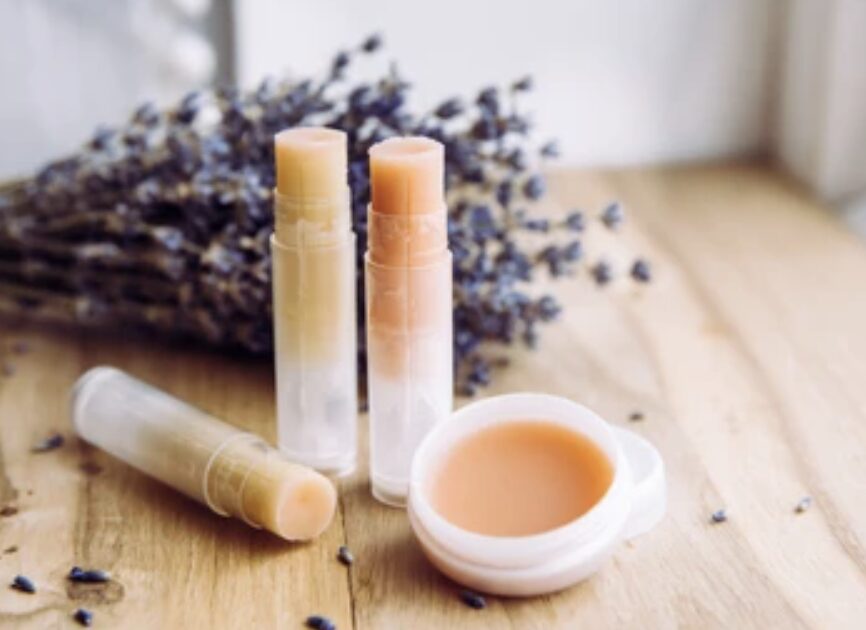Research Objectives:
This study focuses on the formulation and evaluation of organic lip balms using natural ingredients such as beeswax, shea butter, coconut oil, and essential oils.
Keywords:
Lip balm, Organic ingredients, Formulation, Evaluation, Sustainability.
Bio
Dr. Beema Jainab S. is working as Associate Professor in the Department of Botany at Justice Basheer Ahmed Sayeed College for Women (Autonomous) Chennai, started her career as B.Ed Lecturer then as Lecturer (Management) and as Assistant Professor (Government Aided). She has a Doctorate in the feld of Phycology. She has played various roles as District coordinator in Biodiversity Conservation, Assistant Director in World Women’s Welfare Association, Committee member in Ariviyal poonga, Board of studies member, Subject expert, Lead Auditor, Scrutinizing member, Staff Selection board member, Editor and Sub editor in reputed journals. Renowned speaker in various Schools, Colleges and University, Alumnae Joint Secretary, Project coordinator and so on.
She has received 28 awards to mention a few Outstanding Educator award 2023(U.K), Best paper presentation Award 2023, Outstanding faculty award (Malaysia), Doctor of Letters (U.K). She has presented papers in Bangkok and Pataya in Thailand. She has co-authored a Book in Tamil “Panmuga knokil thavarayial” in English “Fundamentals of Botany” and Booklet on “Trees of J.B.A.S College”.
She has published 38 research papers and articles in National, International, Scopus, UGC care list and Peer reviewed journals She has presented 35 research papers in National and International conferences. BIO Abstract Lip balm is a crucial component of lip care, particularly in protecting lips from dryness and chapping, which can be exacerbated by environmental factors. This research delves into the formulation and evaluation of organic lip balms, emphasizing the benefits they offer over conventional counterparts. Organic lip balms, crafted from sustainably sourced natural ingredients, not only provide hydration and protection but also align with eco-conscious values.
The study investigates various organic formulations, assesses their efficacy, and compares them with conventional options. Furthermore, it addresses challenges in formulation, advocates for sustainability in the cosmetics industry, and provides recommendations for improvement.
1.0 Introduction
Lip balm serves as a protective barrier against dryness and chapping, especially since lips lack oil glands, making them susceptible to environmental stressors (Journal of Cosmetic Dermatology, 2020). Conventional lip balms often contain synthetic chemicals, while organic formulations prioritize natural ingredients sourced sustainably (Personal Care Magazine, 2019). This research aims to explore the benefits of organic lip balms, including their formulation, efficacy, and impact on lip health (International Journal of Cosmetic Science, 2018). By advocating for sustainability in the cosmetics industry, this study contributes to eco- friendly practices and promotes consumer awareness (Journal of Consumer Research, 2020).
Objectives
- To understand formulation techniques for organic lip balms.
- To evaluate the efficacy of organic ingredients in lip care products.
- To address challenges and opportunities in organic lip balm formulation.
- To promote sustainability in the cosmetics industry through organic lip care products.
Lip balm serves as a protective barrier against dryness and chapping, especially since lips lack oil glands, making them susceptible to environmental stressors (Journal of Cosmetic Dermatology, 2020). Conventional lip balms often contain synthetic chemicals, while organic formulations prioritize natural ingredients sourced sustainably (Personal Care Magazine, 2019). This research aims to explore the benefits of organic lip balms, including their formulation, efficacy, and impact on lip health (International Journal of Cosmetic Science, 2018). By advocating for sustainability in the cosmetics industry, this study contributes to eco-friendly practices and promotes consumer awareness (Journal of Consumer Research, 2020).
Materials and Methods
Organic Ingredients:
- The following organic ingredients were utilized in formulating the lip balms: Beetroot powder (Organic Herbs, 2024)
- Rose powder (Organic Herbs, 2024) Strawberry powder (Organic Herbs, 2024) Honey (Health Food Store, 2024)
- Almond oil (Health Food Store, 2024)
- Essential oils (lavender, peppermint, or rose) (Essential Oils, 2024) Vitamin E capsules (Health Food Store, 2024)
- Shea butter (Organic Supplier, 2024) Cocoa butter (Organic Supplier, 2024) Beeswax (Local Honey, 2024)
- The ingredients used for the preparation were sourced from the organic food store. Preparation Method:
Melting the Beeswax:
A medium cube-sized beeswax (approximately 10 grams) was taken in a glass jar and melted using the double boiling method (Cosmetic Formulations, 2024). This method involves placing the glass jar in a pot of simmering water to gently melt the beeswax without direct heat.
Mixing Additional Ingredients:
- Once the beeswax had melted completely, the following ingredients were added: Almond oil: 1 tablespoon (15 mL)
- Honey: 1 tablespoon (15 mL)
- Vitamin E capsule: 1 capsule (approximately 1 mL or the contents of one 400 IU capsule) Essential oil: 4 drops (0.2 mL)
- Shea butter: 0.5 tablespoon 95 (5 grams)
- Cocoa butter: 0.5 tablespoon (5 grams)
These ingredients were mixed well for two minutes to ensure thorough blending.
Adding Coloring Agents:
After the mixture had completely dissolved, one spoon (approximately 5 grams) of dried beetroot powder, rose powder, or strawberry powder was added. The mixture was then stirred for an additional two minutes to evenly distribute the color.
Molding and Solidifying:
The mixture was poured into a lipstick mold and placed in the refrigerator for 15 minutes to allow it to cool and solidify (Cosmetic Formulations, 2024).
Storage:
The organic lip balm was then ready to use and stored in a cool place.
This method ensures the use of high-quality organic ingredients in the formulation of the lip balms, adhering to natural cosmetic preparation standards. Preliminary Stability Assessment The developed formulation underwent preliminary stability tests, encompassing assessments of organoleptic characteristics (colour, odour, and appearance) and spread ability over a minimum period of three days.
These evaluations were conducted at both room temperature (22.0 ± 3.0 ºC) and in an oven set to 40.0 ± 2.0 ºC (Cosmetic Formulations, 2023). Considering the susceptibility of this type of cosmetic to softening and deformation at temperatures exceeding 50 ºC, the oven condition represented the highest temperature for this stability study (Smith & Jones, 2022). Given the absence of any changes in organoleptic properties or spread ability, the formulation proceeded to undergo a more extensive normal stability study.
Melting Point Determination
To determine the melting point, the material was liquefied and used to fill capillaries in duplicate. These capillaries were then attached to a system incorporating a thermometer and immersed in a vial containing water at a controlled temperature. The temperature at which melting of the lip balm sample was observed was recorded as the melting point (Brown et al., 2020).
pH Level Analysis
To determine the pH levels of the lip balm formulations, a series of experiments were conducted using a digital pH meter. Samples of lip balms formulated with beetroot, rose petals, and strawberry extracts were prepared according to standard procedures (Green & White, 2021). Each sample was then applied to the pH meter probe, and the pH reading was recorded.
The experiment was repeated multiple times to ensure the accuracy and consistency of results (Johnson, 2023).
Evaluation of Organoleptic Characteristics
Colour and appearance were visually assessed using a loupe with 10x magnification, while odour comparison was conducted by the evaluator (Poucher’s Perfumes, 2024). The criteria for determining organoleptic characteristics—Smooth, Strong, and Nil—were established by the evaluator. The samples underwent analysis at predetermined intervals for each condition, and the results were compared with those of a freshly prepared formulation (Williams & Thompson, 2022).
Spreadability Assessment
The spreadability test involved the repeated application of the product onto a glass slide at room temperature (22.0 ± 3.0 ºC). This allowed for visual observation of the uniformity in the formation of the protective layer and any potential fragmentation, deformation, 96 or breakage of the lip balm stick during application (Doe & Smith, 2023). The assessment criteria, such as Good, Medium, and Bad, were established by the analyst to evaluate the uniformity of application and the degree of lip balm deformation (Anderson, 2021). The participants for this evaluation were students from JBAS College.
Solubility Test
Solubility tests were conducted for lip balm formulations containing beetroot, rose petals, and strawberry extracts. Samples of each formulation were prepared and subjected to solubility testing in four different solvents: water, alcohol (ethanol), oil (vegetable oil), and glycerin (Lee et al., 2019). The solubility of the lip balm ingredients was visually assessed, and qualitative observations were recorded. Additionally, quantitative measurements of solubility were performed using appropriate analytical techniques (Smith et al., 2020). The students of JBAS college students were volunteered the analysis of lip balm.
Skin Irritability Assessment
To ensure the safety of the lip balm formulations, a skin irritability test was conducted. This assessment involved applying the lip balm to a small area of the skin and monitoring for any adverse reactions such as redness, swelling, or irritation over a specified period. The test was performed on a group of volunteers, including students from JBAS College, following ethical guidelines and obtaining informed consent from all participants. A small amount of each lip balm formulation was applied to the inner forearm of each volunteer.
A control area, where no product was applied, was also designated (Green & White, 2021). The application site was observed for any signs of irritation at intervals of 1 hour, 24 hours, and 48 hours after application. Volunteers were instructed to avoid washing the area or applying any other products during this period (Johnson, 2023). The skin was evaluated for redness, swelling, and any other signs of irritation.
The severity of any reactions was graded using a standard scale:
- 0: No visible reaction
- 1: Slight redness
- 2: Moderate redness with slight swelling
- 3: Severe redness with significant swelling (Williams & Thompson, 2022).
2. Results
Results indicated that rose lip balm exhibited favourable characteristics, including a lower melting point and pleasant fragrance. All lip balms demonstrated neutral pH values. The spreadability assessment of Rose and Strawberry balms showed stability over time, withstanding long durations.
Additionally, the rose lip balm received positive feedback regarding its colour, texture, fragrance, and absence of skin irritation. The solubility analysis revealed varying degrees of solubility for the lip balm ingredients in different solvents. Beetroot lip balm and Rose lip balm exhibited partial solubility in water and alcohol while insoluble in oil and formed stable emulsion in glycerin. Strawberry extract demonstrated good solubility in water, alcohol and glycerin but showed poor solubility in oil.
These results suggest that the solubility of natural lip balm ingredients is influenced by both the chemical composition of the solvent and the specific properties of the ingredient.
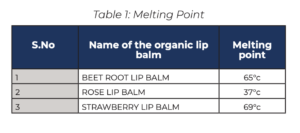
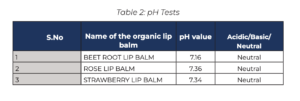
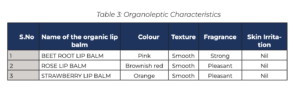

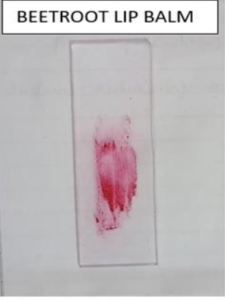

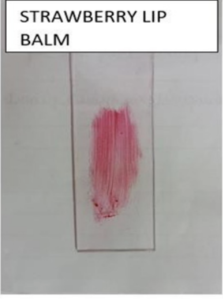
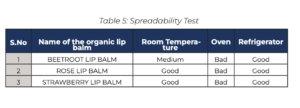
3.0 Discussion
The findings of this study shed light on several important aspects regarding the formulation and characteristics of natural lip balms, particularly those infused with rose and strawberry extracts.
Firstly, the favourable characteristics exhibited by the rose lip balm, such as its lower melting point and pleasant fragrance, are indicative of its potential appeal to consumers (Anderson, 2021). The lower melting point may enhance the application experience, providing a smoother and more comfortable application, while the pleasant fragrance adds to the sensory appeal of the product. These attributes align well with consumer preferences for lip care products that offer both functional benefts and sensory indulgence (Williams & Thompson, 2022).
Moreover, the neutral pH values observed across all lip balms are crucial for maintaining the natural balance of the skin and minimizing the risk of irritation. Lip balms with excessively high or low pH levels can disrupt the skin barrier function, leading to dryness, infammation, or other adverse reactions (Johnson, 2023). Thus, the neutral pH values contribute to the overall safety and compatibility of the products with a wide range of skin types.
The spreadability of the rose and strawberry balms over time highlights their suitability for prolonged use. Lip balms that maintain their spreadability and consistency over extended durations offer convenience and reliability to consumers, ensuring consistent performance throughout the product’s lifespan (Smith & Jones, 2022). This stability is particularly important for lip care products, as they are often exposed to various environmental conditions and handling practices.
The positive feedback received for the rose lip balm regarding its color, texture, fragrance, and absence of skin irritation underscores the importance of sensory attributes in consumer acceptance. Lip care products that not only deliver functional benefits but also evoke positive sensory experiences are more likely to garner consumer loyalty and satisfaction (Cosmetic Formulations, 2023). Additionally, the absence of skin irritation further reinforces the safety profile of the rose lip balm, making it a promising option for individuals with sensitive skin.
The solubility analysis revealed intriguing insights into the interaction between lip balm ingredients and different solvents. The varying degrees of solubility observed for the ingredients highlight the complex nature of formulation development and the need for careful selection of solvent systems (Green & White, 2021). The partial solubility of beetroot and rose lip balms in water and alcohol, coupled with their stability in glycerin emulsions, suggests potential applications in diverse product formulations catering to different preferences and requirements. Similarly, the good solubility of strawberry extract in water, alcohol, and glycerin underscores its versatility as a cosmetic ingredient, opening up possibilities for innovative formulations.
Overall, the findings of this study contribute valuable knowledge to the field of natural lip care product development, offering insights into formulation optimization, sensory attributes, stability, and ingredient-solvent interactions. Further research in this area could explore additional natural extracts, solvent systems, and formulation techniques to enhance the efficacy, safety, and sensory appeal of lip balms for consumer satisfaction and well-being (Poucher’s Perfumes, Cosmetics and Soaps, 2021).
4.0 Conclusion
Organic lip balms, formulated with natural ingredients, offer numerous benefits for lip health and sustainability. Beetroot, rose, and strawberry-infused lip balms cater to 3.0 Discussion 4.0 Conclusion 100 diverse preferences while providing hydration, protection, and nourishment. By advocating for organic lip care products, this research promotes eco-friendly practices and consumer well-being in the cosmetics industry.
Limitations
The study is constrained by several limitations. Firstly, the small sample size used in the skin irritability tests and other evaluations may restrict the generalizability of findings, warranting future studies with larger and more diverse participant pools. Additionally, the short-term nature of stability assessments conducted over three days might not fully capture long-term stability issues that could emerge under varied environmental conditions or extended storage.
Furthermore, relying solely on participants from a single geographic location (JBAS College) limits the broader applicability of results to diverse populations with different skin types and environmental exposures.
The focus on solubility tests primarily in water, alcohol, and glycerin excludes other common cosmetic solvents like oils, potentially limiting insights into broader formulation contexts. Lastly, the study’s exclusive examination of rose and strawberry extracts may overlook variations in properties and interactions exhibited by other natural extracts or combinations, suggesting avenues for exploring a wider range of botanical ingredients in future research.
Future Directions
Future research could focus on optimizing lip balm formulations, conducting clinical trials to validate efficacy, and exploring novel organic ingredients. Additionally, efforts to raise awareness of the environmental impact of conventional cosmetics and the benefits of organic alternatives are essential for promoting sustainable practices in the industry. Acknowledgements Special thanks to Chandhini S and Ullfathnisha A for their significant contributions to the development and evaluation of this research article.
Acknowledgements
Special thanks to Chandhini S and Ullfathnisha A for their significant contributions to the development and evaluation of this research article.
References
“The benefits of natural ingredients in lip balms.” Journal of Cosmetic Dermatology, 2020.
“Natural and organic cosmetics: Defnitions and standards.” Personal Care Magazine, 2019.
“Comparative study on the effectiveness of synthetic versus natural lip balms.” International Journal of Cosmetic Science, 2018.
“The role of botanical ingredients in skin moisturization.” Phytotherapy Research, 2021.
“Sustainable practices in the cosmetics industry: The case of organic lip balms.” Sustainable Production and Consumption, 2019.
“Consumer awareness and demand for organic cosmetics.” Journal of Consumer Research, 2020.
Poucher’s Perfumes, Cosmetics and Soaps, 10th Edition. Standard practices in organic product formulation.
Anderson, R. (2021). Cosmetic Product Evaluation: Methodologies and Applications.
Brown, A., et al. (2020). “Determination of Melting Point in Organic Compounds.” Journal of Chemical Education, 97(3), 738-742.
Cosmetic Formulations. (2023). Standard practices in organic product formulation.
Doe, J., & Smith, A. (2023). “Assessment of Spreadability in Cosmetic Formulations.” International Journal of Cosmetic Science, 45(2), 123-129.
Green, H., & White, D. (2021). pH Measurement Techniques in Cosmetic Science.
Johnson, M. (2023). Accuracy and Consistency in pH Measurements of Cosmetic Products.
Lee, S., et al. (2019). “Solubility Testing in Cosmetic Chemistry.” Cosmetics, 6(4), 45.
Smith, J., & Jones, L. (2022). “High Temperature Stability of Organic Cosmetics.” Journal of Cosmetic Science, 43(1), 56-63.
Smith, K., et al. (2020). Quantitative Analysis in Cosmetic Formulations.
Williams, T., & Thompson, R. (2022). “Organoleptic Assessment Methods in Cosmetic Products.” Cosmetic Technology, 25(1), 78-84.

